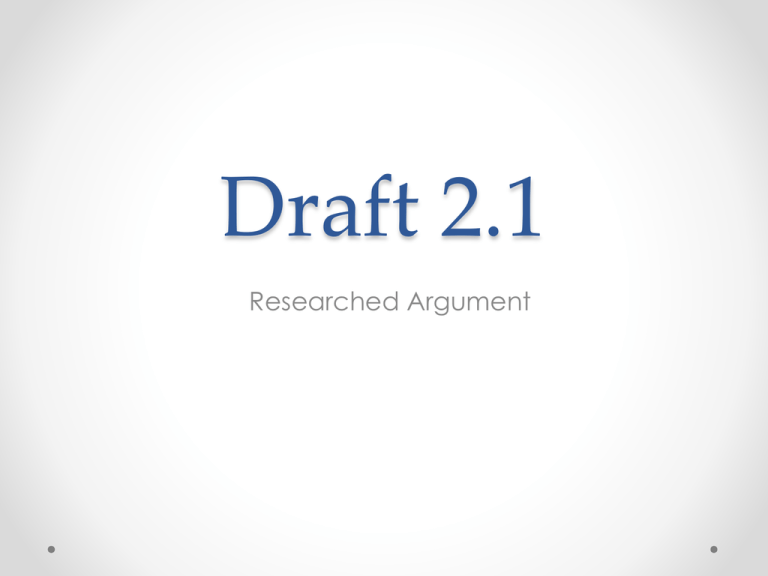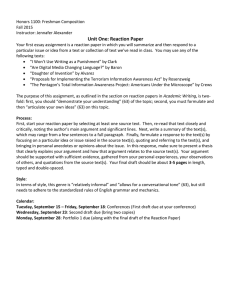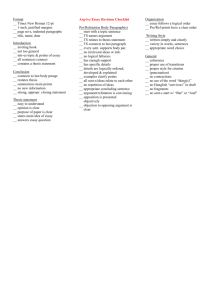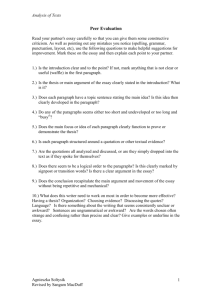Draft 2.1 - WordPress.com
advertisement

Draft 2.1 Researched Argument Free Write • Watch the following video clip, Neil deGrasse Tyson at UB: What NASA Means to America's Future, and respond using the following questions as guides: o What is Tyson’s argument? What is his thesis statement? What is his purpose? o What types of rhetorical appeals does he use? o How does he construct his ethos? Does he do so effectively? o What do you think of his argument? Assignment: Draft 2.1: Researched Argument • Objective: To practice locating and evaluating sources and then integrating those sources into a researched argument. • Description: To complete this assignment, write an argument using the strategies and structures described in your textbook and the handbook. The argument should have an identifiable thesis, lines of argument, logical support, ethical and emotional appeals (if applicable), and consideration of alternative views. • You should use 6 sources from the TTU library or library databases as specified by your instructor for this assignment. Your essay should be 1500 words in length, not including the list of works cited. Please use MLA format (see Ch. 16 of your handbook) for in-text citations and your list of works cited. Scoring Guide C1—Issue Identification and Focus Has the student focused his or her argument on a narrow topic? Is the essay argumentative rather than informative? Are the claims presented in the argument concrete and specific? C2—Context and Assumptions Has the student considered the contexts of the articles which he or she quotes? Has the student discussed any assumptions which he or she makes about the topic as well as the assumptions which the articles make? C3—Sources and Evidence Has the student presented sources effectively to support his or her points? Are all points supported with scholarly work? the sources credible? Has the student cited these sources correctly? Is the Works Cited list formatted correctly? Has the student cited all of the sources listed in the Works Cited? C4—Diverse Perspectives Does the student consider the counterargument fairly and carefully? Do the articles which the student cites in the counterargument support the counterargument and not the argument? Sometimes, students will “borrow” a summary of the counterargument from a source that they have been using to support their own lines of argument. C5—Own Perspective Has the student clearly stated an arguable thesis statement? Do the lines of argument provide adequate support for this thesis statement, and is it clear how they support it? C6—Conclusion Does the student summarize the main points the student has made? Does the conclusion restate the thesis statement? How effective is the conclusion rhetorically? C7—Communication Is the essay clearly organized and easy to follow? Can you tell which paragraphs are lines of argument? Is it clear how every paragraph helps to develop the thesis statement? How effective is the student’s writing at the sentence level? Organization Thesis Statements • Anticipate readers’ needs • Consider how much prior knowledge readers are likely to bring to the subject • Clear and focused • Should be problematic • Embed the thesis statement in purpose and organization • Consider guiding readers into the essay by describing the purpose of your research and outlining the organization of your argument Introductions • A striking or memorable quotation by a major figure related to the research question or purpose • A brief sketch of a debate among experts to be evaluated in detail in the essay • A summary of the history of an issue or debate, and why it’s relevant now • A rhetorical question posed to readers • A forecasting statement indicating the organization and main points of the argument • A thesis According to the Evan B. Donaldson Adoption Institute, there are 1.5 million children adopted in the United States each year (Fields and Jason par. 1). In recent years, there has been a shift in the choice between open or closed adoption, as researchers are beginning to challenge the idea that closed adoption is the only effective practice. This questioning affects 1.5 million children and their families. Adoption is becoming more common and there is a chance you or someone in your family will someday adopt a child. This could affect you or someone in your family, too. Even though many researchers claim closed adoption is the most traditional and logical choice for adoption cases, more and more researchers are encouraging to consider open adoption for all cases. Because open adoption is found to be favored by adoption triads and has shown to be beneficial, open adoption should clearly be considered in all adoption cases. Sample Introduction • Locate the purpose of the essay • Locate the thesis statement • What kind of organizational strategy does the writer use to introduce us to her essay? • What are the strengths and weaknesses of this introduction? Activity 8.2 (from p. 181) Draft an introduction for your formal research essay using the outline you have brought to class. It should incorporate some of the strategies introduced here. Open with a “hook” State a tentative thesis Forecast the organization of your project Activity 8.2 cont. • Exchange introductions with a peer reviewer. Reviewers should consider: How did the writer choose to introduce the project? Does the writer include a thesis statement in the introduction? Whether yes or no, is the decision logical? Does the writer forecast the organization and/or major points to be developed in the rest of the essay? What else would you like to know as the essay begins? Body Paragraphs • Start each paragraph with a clear topic sentence • Use sources to support the argument you have made in your thesis statement • Integrate quotations into your sentences • Instead of block quotes, paraphrase information and only quote phrases that couldn’t be said by you better (you must cite paraphrases) • Use transitions between sources • Forecast the next section of your essay Contact with the birth parents can considerably improve the adopted child’s well being. An adopted child could feel rejected from his birth parents because they do not understand why they were given up. The child can feel as if there was something wrong with them and that’s why they were given up. Annette Baran and Reuben Pannor, child psychologists, explain a story about an adopted child Johanna who was part of a closed adoption with no contact with her birth parents that sent private investigators out to search for her birth mother. When they found the mother and reunited Johanna and her biological mom, Johanna claimed that she felt “relieved and finally knew the truth to why she was given up” (Baran and Pannor 327-328). Open adoption can considerably lessen the adopted child’s feelings of rejection. As the child matures they can realistically have an understanding of the reasons their birth parents gave them up for adoption (Rompf 220). Researchers have found a consensus in studies that adopted children with contact with their birth parents experience improved psychological changes such as improved self-esteem and self-perception (221-222). Other research has shown that the adopted child develops a positive identity as an adopted person (Jones and Hackett 159). Also, there has been no evidence found that contact between the adopted child and birth parents is harmful to the child’s well being (Grotevant et al. 96). Thus, we can conclude that if an adopted child has open contact with their birth parents then they will develop as healthier adopted adults, physically and mentally. Sample Body Paragraph Locate the topic sentence Which types of appeals are being used (logical, emotional)? Locate transitions between quotations and evidence. What are the strengths and weaknesses of this paragraph? Is the following paragraph forecasted at all in this paragraph? Activity Your outlines should already contain topic sentences. Now write some transitions between paragraphs and/or quotations/supports. Exchange outlines with a peer reviewer. Reviewers should read the thesis statements and the topic sentences. o o o o o What kinds of discrepancies exist between them? Do all of the topic sentences directly support the thesis? Does the organization of the essay support the argument being made? Do the transitions set up a logical flow of information and argumentation? What could be done to further enhance either topic sentences, transitions, and organization of this essay as it currently stands? Addressing Counterarguments • Anticipate challenges readers might make against your claim • Refute or concede the counterargument • Shows readers that you are fair, which enhances your personal ethos • Either work in counterarguments for points you make in each body paragraph or put counterarguments in their own paragraph (typically follows your own arguments) Even though open adoption has been found by many studies to be very beneficial for all groups of an adoption triad, some people are still against open adoption and wish to practice the traditional, closed adoption. Some surveys claim that a majority of the United States is still skeptical of open adoption. Proponents for closed adoption fear that open contact between the birth parents, adopted child, and adoptive parents could cause complications in the child’s identity. Closed adoption advocates claim that contact with the birth parents would interfere with the bonding between the child and the adoptive parents (Siegel 410). However, studies and researchers have already proven the contact with the birth parents significantly improve a child’s well being and strengthen the relationship between the child and adoptive parents. Sample counterargument paragraph • What is/are the counterargument(s) • Does the writer refute or concede them? • What are the strengths and weaknesses of this paragraph? Conclusions • Demonstrate the broader significance or application of the issue you’ve addressed • Recommend action that should be taken • Propose directions for further research • Revisit a quotation or anecdote with which you opened the essay • Revisit a key example or illustration from the essay Open adoption has been proven by researchers and studies to provide multiple benefits for the birth parents, adoptive parents, and adopted child. Open adoption can facilitate the birth parents’ grieving process. Adoptive parents can feel more at ease about the birth parents and strengthen their relationship with the child by giving the adoptive parents the reassurance that they can take on the parental role. Open adoption also aids in the positive well being of the adopted child. There are 1.5 million adoptions in the United States each year; thus, choosing open or closed adoption affects millions of children, birth parents, and adoptive parents. It could even affect you someday, and the benefits of open adoption should strongly be considered if you ever become involved in an adoption process. Conclusion Paragraph • Is the purpose of the essay stated? • Is the thesis of the essay stated? • Are the primary arguments summarized? • Which conclusion strategy has been used? Homework • We will be peer reviewing your essays on Monday, August 6. Please bring a completed draft printed on paper to class that day. • There is a sample Draft 2.1 (the entire paper that I’ve used throughout this presentation) in the back of your book on page 504. Its revised version, completed for Draft 2.2 is located on page 504. • I have also posted a Draft 2.1 to the blog. This draft was written by a student last semester and contains revision comments.







